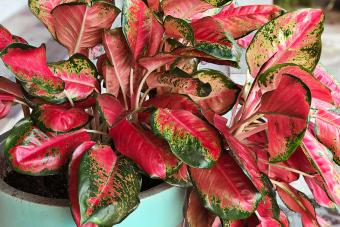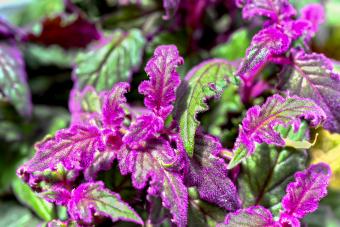
Want to add a pop of color to your home? Houseplants don't have to be limited to green, or even basic green and white variegation. Growing colorful indoor plants is a great way to add natural color to your home. Some houseplants bloom occasionally, but that's not the only option for bringing colorful botanical beauty into your home. For full-time (or nearly full-time) color, add some (or all!) of the plants below to your houseplant collection.
African Violet

African violets (Saintpaulia ionantha) have gorgeous purple flowers that can bloom almost all the time, as long as they get enough light and stay evenly moist. They need 8-12 hours of indirect sunlight per day, so you may need to move them around to different windows as the seasons change, or supplement natural light with grow lights. They also need at least eight hours of dark each day. Add water as soon as the top of the soil is dry.
Arrowhead Vine

Most arrowhead vine (Syngonium podophyllum) plants have green or green and white leaves, but some varieties - such as the patented neon robusta (Syngonium podophyllum 'Neon Robusta') - have colorful pink and green leaves. The pink varieties need bright or medium indirect light (the brighter the light, the pinker the leaves). Water this trailing plant when the first inch of soil gets dry.
Chinese Evergreen

Most Chinese evergreen (Aglaonema) plants have green or green and white leaves, but some cultivars - such as Aglaonema 'Siam Aurora' or Aglaonema 'Pink Splash' - have colorful splashes of red or pink. Commonly called red Chinese evergreens (even if they're more pink than red), these colorful indoor plants do best in medium indirect light. Wait for the top two inches of soil to dry out before watering.
Croton

Croton (Codiaeum variegatum) is a beautiful multicolored tropical houseplant. Assuming it gets plenty of bright, indirect light, this plant's mostly green leaves will have vivid plashes of color - including burgundy, orange, pink, red, and/or yellow. Water when the first inch or two of soil gets dry. Because this plant needs humidity, put its container on a pebble-filled saucer with a little water in the bottom (below the top of the pebbles).
Flamingo Flower

Flamingo flower (Anthurium), aka flamingo lily or laceleaf, is a tropical houseplant with mostly green leaves. When they bloom - which generally happens in 90-day cycles - they produce brightly colored heart-shaped leaves with a spike of tiny flowers in the center. They thrive in bright, indirect light, but may also bloom in medium light. Water when the first few inches of soil are dry.
Jelly Bean Plant

Jelly bean plant (Sedum rubrotinctum) is a mostly green succulent that has vibrant red rounded tips that look more than a bit like - you guessed it! - jelly beans. This plant needs a lot of bright, indirect light; it'll even do well in full sun. If you don't have a very sunny window and want vibrant red color, use a grow light. Follow standard succulent watering instructions of letting the plant totally dry out, then soak it thoroughly.
Moon Cactus

Moon cactus (Gymnocalycium mihanovichii) is another indoor succulent that's really cool. These interesting plants come grafted to a rootstock because they can't produce chlorophyll on their own. They come in pink, orange, yellow, or red. They're small plants, so you can group several together for a multicolored display. Moon cacti need indirect sunlight for four to six hours per day. Water when the soil is completely dry.
Nerve Plant

Nerve plants (Fittonia) often have green leaves with white veins, but some cultivars - such as Fittonia 'Black Star' or Fittonia 'Fortissimo' - have pink or red veins. The leaves of Fittonia 'Frankie' are predominantly pink. These plants do best in bright indirect light. They'll also do fine in medium indirect light, but their color won't be as vibrant. Add water when the first inch of soil is dry. Keep its container on a saucer filled with damp pebbles.
Velvet Plant

Passionate about purple? Consider adding a velvet plant (Gynura aurantiaca), aka purple passion plant, to your home or well-lit office. This cascading plant is mostly green, but it has bright purple hairs that grow in a vibrant outline around its leaves, which feel like velvet to the touch. It prefers bright indirect light, but will also do well in moderate light (though the purple will be less intense). Water when the surface of the soil gets dry.
Sign up for our newsletter featuring all the latest stories and products we love.
Ti Plant

Ti plant (Cordyline fruticosa) is a tropical plant commonly grown as a small indoor tree with colorful leaves. Its leaves are usually red or purplish-red with green, though they may sometimes also inlcude yellow and/or white. They need bright, filtered light, consistent moisture, and humidity. Water when the top inch or two of soil gets dry. Keep the container on top of a saucer filled with damp pebbles.
Growing Tips Colorful Indoor Plants

With the right plants - and a lot of sunlight - you can absolutely grow colorful indoor plants. Follow the tips below for the best results.
- Light is a must for colorful plants. If you put a plant known for color in an area that doesn't get much light, it also won't display much - or any - color.
- If your colorful plant isn't very colorful, try moving it to an area that gets more sunlight or adding a fluorescent grow light to supplement the natural light.
- The days are shorter during winter, so you may need to use grow lights to keep your plants colorful - even ones that are in the sunniest places in your house.
- Fertilize your colorful indoor plants using commercial plant spikes or a liquid plant food. Apply per package directions.
Beautify Your Home With Colorful Indoor Plants

Growing houseplants is a great way to make your home uniquely yours. Whether you prefer mostly green foliage or you're looking to brighten up your space with colorful plants that put on a show in every season, there are plenty of options to consider.







